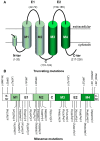DFNB1 Non-syndromic Hearing Impairment: Diversity of Mutations and Associated Phenotypes
- PMID: 29311818
- PMCID: PMC5743749
- DOI: 10.3389/fnmol.2017.00428
DFNB1 Non-syndromic Hearing Impairment: Diversity of Mutations and Associated Phenotypes
Abstract
The inner ear is a very complex sensory organ whose development and function depend on finely balanced interactions among diverse cell types. The many different kinds of inner ear supporting cells play the essential roles of providing physical and physiological support to sensory hair cells and of maintaining cochlear homeostasis. Appropriately enough, the gene most commonly mutated among subjects with hereditary hearing impairment (HI), GJB2, encodes the connexin-26 (Cx26) gap-junction channel protein that underlies both intercellular communication among supporting cells and homeostasis of the cochlear fluids, endolymph and perilymph. GJB2 lies at the DFNB1 locus on 13q12. The specific kind of HI associated with this locus is caused by recessively-inherited mutations that inactivate the two alleles of the GJB2 gene, either in homozygous or compound heterozygous states. We describe the many diverse classes of genetic alterations that result in DFNB1 HI, such as large deletions that either destroy the GJB2 gene or remove a regulatory element essential for GJB2 expression, point mutations that interfere with promoter function or splicing, and small insertions or deletions and nucleotide substitutions that target the GJB2 coding sequence. We focus on how these alterations disrupt GJB2 and Cx26 functions and on their different effects on cochlear development and physiology. We finally discuss the diversity of clinical features of DFNB1 HI as regards severity, age of onset, inner ear malformations and vestibular dysfunction, highlighting the areas where future research should be concentrated.
Keywords: DFNB1; GJB2; GJB6; connexin-26; connexin-30; hearing impairment; inner ear.
Figures




References
-
- Ambrosi C., Walker A. E., Depriest A. D., Cone A. C., Lu C., Badger J., et al. . (2013). Analysis of trafficking, stability and function of human connexin 26 gap junction channels with deafness-causing mutations in the fourth transmembrane helix. PLoS One 8:e70916. 10.1371/journal.pone.0070916 - DOI - PMC - PubMed
-
- Anselmi F., Hernandez V. H., Crispino G., Seydel A., Ortolano S., Roper S. D., et al. . (2008). ATP release through connexin hemichannels and gap junction transfer of second messengers propagate Ca2+ signals across the inner ear. Proc. Natl. Acad. Sci. U S A 105, 18770–18775. 10.1073/pnas.0800793105 - DOI - PMC - PubMed
Publication types
LinkOut - more resources
Full Text Sources
Other Literature Sources
Miscellaneous

